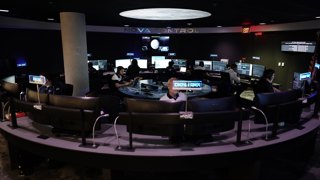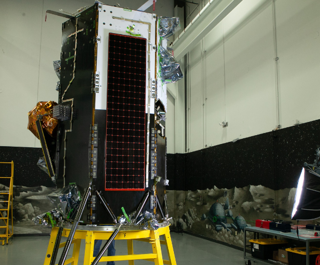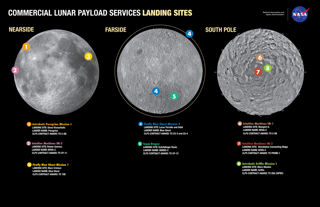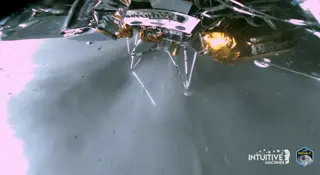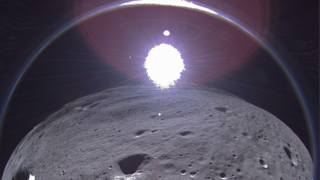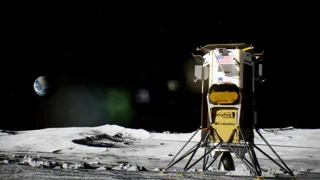
Intuitive Machines - IM-1 mission
- 7th Feb 2024
- Author: Dhara Patel
Roses are red,
violets are blue,
IM-1 aims for a lunar landing,
but will it be able to?
Intuitive Machines plans to launch the IM-1 mission, with a lunar lander named Odysseus on Valentine's day. They aim to touch down on the Moon and become the first private company in history to achieve the feat. But with several failed attempts from other commercial and national space organisations over the past year, it's definitely not as easy to conduct a soft landing on the Moon, as one might be led to think!
What's the plan?
No earlier than 14 February 2024, Intuitive Machines (a US based space exploration and infrastructure company) plans to launch their Nova-C lander. Lifting off on a SpaceX Falcon 9 rocket from Florida's Cape Canaveral Space Force Station, it aims to land on the Moon roughly eight to nine days later. The lander, called Odysseus, will carry six NASA payloads to carry out scientific investigations on the Moon along with commercial cargo including sculptures, a camera, and a thermal reflective material for testing.
IM-1 is targeting a landing site about 300 kilometres from the Moon’s south pole and will have roughly seven days for experiments and demonstrations to be carried out before the lunar night sets in and the spacecraft becomes inoperable. This mission’s main objective is to deliver multiple payloads to the south pole region of the Moon – a place that remains relatively unexplored but is targeted as a site for future human and robotic exploration of the Moon, notably with NASA’s Artemis Program.
Napkin doodles to pioneering innovations - who are Intuitive Machines?
Intuitive Machines was founded in 2013 by co-founders Steve Altemus and Dr Kam Ghaffarian. A casual conversation between the pair at a dinner in Washington D.C. sparked a visionary idea from Altemus, who jotted down the initial ideas for Intuitive Machines on a napkin. Over a decade later the company are driving forward cutting-edge solutions to help solve some of humanity’s biggest challenges in space.
In 2018 the US refocused on returning to the Moon and the following year Intuitive Machines were the first to receive a task order of delivering science payloads to the Moon for NASA through their Commercial Lunar Payloads Service (CLPS) programme. And over the past few years, the company have been building an entire space programme which includes the lander, mission control and a network to support spacecraft data transmission at distances of 250 million miles (the rough distance to the Moon).
Greek hero Odysseus - namesake of the lunar lander
The Nova-C lander is named Odysseus, after the Greek hero whose story was told in Homer's 'The Odyssey'. In the mythology, Odysseus spent years overcoming obstacles to journey home after the events of the Trojan War, to regain his kingship (or for the Valentines love-story alternative, to return to his wife Penelope).
In a similar vein, Odysseus the Moon lander has a long journey to the Moon. It's been years in development, and the launch and flight to land on the Moon will be the climax of this epic tale - fingers crossed it's a happy ending for this hero.
Six of one, half a dozen of the other
Nova-C is roughly the size of an old school British police phone box like the TARDIS in Doctor Who. The flight will carry six NASA payloads, including instruments capable of investigating:
- plume-surface interactions (how the plume exhaust of a lander interacts with lunar regolith/surface material)
- space weather/lunar surface interactions (how solar radiation and impacts from space rocks interact with the Moon’s surface)
- radio astronomy (using telescopes to detect radio waves from space and turning them into signals we can use to develop our understanding of space)
- precision landing technologies (the ability and confidence to land within a certain distance of the set target site)
- communication and navigation node for future autonomous navigation technologies (a connection point within a network to support communication and navigation)
But as a private mission, Intuitive Machines are able to also take on commercial cargo and they have six of these types of payload onboard too.
Not the only one
At the start of 2024, we saw NASA's first CLPS mission, Peregrine from Astrobotic Technology, attempt a delivery to the lunar surface. But the mission suffered a fuel leak shortly after deploying from Vulcan Centaur rocket's upper stage, scuppering any chance of a lunar landing. After keeping the spacecraft operational for ten days despite the challenges, Peregrine was guided into the Earth's atmosphere for a controlled destruction.
Intuitive Machines are next in the line-up to attempt a landing on the lunar surface, but we'll be seeing a number of CLPS missions target the Moon in the coming years - some heading for the near side, others for the far side, and some for the south pole like Nova-C.
With NASA's Artemis Program gearing up to send astronauts to the Moon in the next few years and other nations planning for crewed lunar exploration in the coming decade, missions like these are helping to enhance our understanding of the Moon's environment and how that may affect humans who journey there.
Making history (post-launch update)
After a delayed launch, the IM-1 mission lifted off on the morning of 15 February. A week later it made history as it landed near Malapert A crater, in the south polar regions of the Moon, becoming the first private mission to successfully touch down on the lunar surface, and the first American landing on the Moon since Apollo 17 over 50 years ago.
After going into lunar orbit, the spacecraft controllers realised the laser rangefinders on Odysseus, used to help with the landing, weren't working. Because the lasers aren't eye-safe there's a safety switch which has to be flipped before launch, but it wasn't. Luckily one of the NASA instruments on board (Navigation Doppler Lidar) was incorporated into the lander's navigation to bring Odysseus down to the lunar surface.
But it turns out the NASA instrument data wasn't validified by the software and so using it's own equipment and algorithms, the lander came in faster, hitting the surface harder and skidding along the way. The landing gear leg was broken and when the engines wound down, the spacecraft gently tipped over.
Due to it's unideal landing but together with the fact that every NASA payload was able to meet some level of their objectives, the mission was deemed an unqualified success.
Data and images from the lander have been beamed back to Earth. And after roughly six days in operation, the Sun moved out of view of the solar panels, drawing a close to the mission as it was placed into a slumber.
But the company did not rule out bringing Odysseus back to life after the two week lunar night - it's not out of the realm of possibility that the spacecraft’s batteries and electronics could survive the frigid conditions out of the sunlight...
Full references / credits:
(Banner image) Intuitive Machines (IM-1) mission. Credit: NASA
(1) Intuitive Machines IM-1 Mission animation. Credit Intuitive Machines https://vimeo.com/748956971
(2) Nova Control is Intuitive Machines' mission control center inside the company's headquarters in Houston, Texas. Credit: Intuitive Machines CC BY-NC-ND 4.0 DEED https://www.flickr.com/photos/intuitivemachines/52349811156/in/photostream/
(3a) Odysseus tells of his adventures to Penelope. Credit: public domain CC0 1.0 DEED https://www.lookandlearn.com/history-images/YR0334689/Odysseus-tells-of-his-adventures-to-Penelope
(3b) Odysseus escapes from the cave of Polyphemus. Credit: public domain CC0 1.0 DEED https://www.lookandlearn.com/history-images/YR0334652/Odysseus-escapes-from-the-cave-of-Polyphemus
(3c) Odysseus and the sirens. Credit: public domain CC0 1.0 DEED https://www.lookandlearn.com/history-images/YR0334667/Odysseus-and-the-sirens
(4) Intuitive Machines’ Nova-C lunar lander inside the company’s facility at the Houston Spaceport. Credit: Intuitive Machines
(5) Commercial Lunar Payload Services (CLPS) landing sites graphic. Credit: NASA
(6a) The broken landing leg of the spacecraft as it touched down faster than planned. Credit: Intuitive Machines
(6b) The final transmission from Odysseus. Credit: Intuitive Machines

